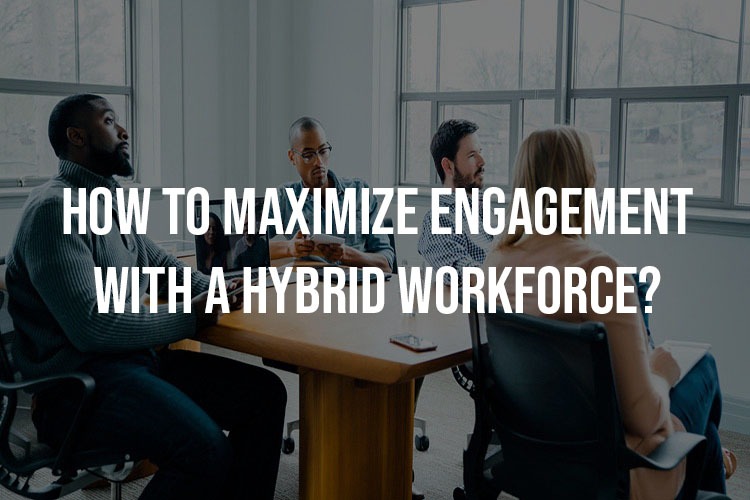The year 2020-2021 will be remembered as a year of upheaval and transformation. The way we worked for centuries was challenged, resulting in the creation of a completely new working model.
It’s no surprise that global productivity grew considerably during the epidemic, albeit at a high cost for some individuals and businesses, thanks to unprecedented levels of virtual team cooperation, more flexible work hours, and less time spent traveling.
And with all this, here is the million-dollar question- how to maximize engagement with a hybrid workforce? The issue of greater employee engagements has long been a problem in the talent market, and the problem has only gotten worse now that so many people work remotely. Despite the challenges, there have been some success stories and examples from across sectors that have successfully implemented an innovative hybrid workforce approach to maximize engagement. During the next phase of adjustment, it will be critical for businesses to have a plan in place to keep employees engaged and improve culture.
Hybrid Workforce – The new normal
Leaders are busy managing the new realities of a hybrid workforce as vaccination rates rise and pandemic restrictions are eased in some areas. According to a McKinsey poll, nine out of ten businesses intend to blend remote and in-office employees in the future. Hybrid teams and workspaces don’t have a one-size-fits-all model, but they do have key characteristics: Some employees work remotely, while others work on-site, and others do both.
With most of the employees stating their desire for continuous flexibility and remote work alternatives, hybrid workforce policies will be essential if companies are looking at attracting great talents across industries.
Now that more teams have returned to work, managers must strike a compromise between diverse employee preferences and the goal to maintain productivity.
This new manner of working might be difficult for leaders, especially at first. Some team members may embrace the opportunity to work from home, while others may be eager to return to the status quo. On a larger scale, each company or organization has its own schedule for when and how it will resume in-person employment.
For leaders, managing a hybrid workforce involves adaptation and a willingness to try new things.
The New World Of Hybrid Workforce Deserve A Whole New Approach To Employee Engagement
After more than a year of epidemic survival, employees’ expectations have evolved. We’ve all been affected by this experience, and employees’ priorities have shifted as a result of new and different tasks. However, this does not negate the need for employee involvement.
Employers in the United States spend between $450 and $550 billion each year on disengaged staff. Highly engaged teams are more profitable by 21%, have 41% reduced absenteeism, and 59 percent lower turnover. Businesses simply cannot afford to put employee engagement strategies on the back burner.
Moreover, most of the employees prefer to have some control over where they work, signaling that remote work in some form or another is here to stay for businesses willing to hire and retain top talent. According to Deloitte, 94 percent of US professionals surveyed felt that having the option to work from home at least part-time would benefit them. Furthermore, roughly a third of employees said they would quit their jobs if they were not allowed to continue working remotely. The rise of hybrid and remote workforces seems assured.
As a result, organizations must redesign their employee engagement methods as quickly as feasible to meet this transformation.
Steps to create an impactful hybrid workforce engagement approach
Employee engagement is a sensitive matter, as proven by its resistance over the last two decades. The reality that not all employee engagement techniques will work for all businesses adds to the complexity of the issue. Here are our top recommendations for keeping employees engaged and productive no matter where they work to make this blog as useful as possible across diverse industries and situations.
Re-instill your mission and values in your employees
People make decisions about choosing a specific company to work for depending on a range of metrics, but your Employer Value Proposition (EVP) and company mission play a significant impact in attracting and retaining talent. Leaders need to evaluate their company’s purpose, brand promise, and values in order to effectively articulate their EVP and mission.
The year 2021 is an excellent opportunity to examine your values and evaluate how the events of 2020 influenced who you are as a company and how you operate. Moreover, reframing your vision and values could be a highly effective means of virtually bringing your hybrid workforce back together after a long period of physical separation.
Also Read: How to prevent Toxic Culture from brewing at the Workplace
Maintain frequency and transparency in your communication
With everyone working remotely, it is natural for employees to feel disengaged and unaware of what is going on in the organization and how they are contributing towards the larger business goal. When they don’t hear frequently about the company’s progress and how different departments are operating- they feel left out and demotivated.
Communication is an important factor of business success and is frequently included in any culture model used to evaluate employee engagement. Effective communication is a top challenge for businesses during normal times. Communication is frequently the lowest, or second lowest, the ranking area in engagement surveys that our clients see in their feedback.
Companies need to raise their frequency of communication with employees. They also need to invest in a new set of tools for the hybrid workforce, including communication platforms like Zoom, Slack, and Teams. The major takeaway here is that businesses should continue to put more emphasis on communication and explore new solutions that can help employees retain high levels of engagement as the workplace changes.
Gather regular input from employees and make quick, data-driven decisions
Another area where the worldwide pandemic has had a significant impact is how organizations gather input from their employees. There have been a significant shift toward lighter-weight, more real-time surveys that are intended to aid in the making of quicker, data-driven decisions.
You’ll get a better sense of how your employees are feeling and uncover opportunities for development if you use a shorter pulse survey. Obtaining regular employee feedback and tracking incidents if any in the right way with the HR team while focussing on solving them can create a more engaged workforce within a hybrid work culture.
Invest in employee’s health and wellness
Employee well-being is the newest mainstay in most HR funnels. It’s no longer an emerging trend; it’s become a must-have. The need to evaluate, monitor, and act on employee feedback through wellbeing surveys is crucial to driving engagement among employees.
Even as constraints loosen, employees’ mental health and well-being should remain a top priority as businesses shift to the new hybrid working paradigm. Businesses can ensure this by setting up one-on-one meetings with employees or hosting mental health awareness events to help create an environment where employees can open up about their health. What you put into employee relationships is ultimately what you get out of them in terms of productivity. Affective mental wellbeing states are increasingly being recognized as a key driver of human behavior, in addition to productivity. Happiness and productivity are linked to strong work culture, even in remote and hybrid workforces.
Offer Strategic Direction To Your Employees
We strongly advise that as you enter 2021, you spend time with your employee and guide them through your ambitions for the year. Consider having a robust “manager communications toolbox” to guarantee that your management team is on board with your strategic plan for 2021. It’s vital that the signals your employees receive from their managers are consistent with the company’s priorities as communicated by your executives.
Conclusion:
As we approach the end of the year, there are many hopeful signals pointing to a return to “normal” in the future, but it’s evident that most businesses will continue to use a hybrid workforce for some time.
During the next phase of adjustment, it will be critical for businesses to have a plan in place to keep employees engaged and improve culture.


